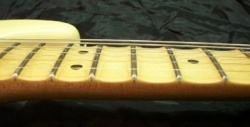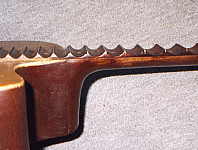Scalloped fretboard
(New page: Category:Gear scalloped fingerboard A fretboard is scalloped when the wood between the frets is scalloped out, creating a soft U sha...) |
m (→Process) |
||
| Line 5: | Line 5: | ||
== Process == | == Process == | ||
| - | The process of scalloping the fretboard is a precise work. It’s | + | The process of scalloping the fretboard is a precise work. It’s normally done by using a file and filing the wood between the frets. It takes a lot of time, but getting it done is expensive. The scalloped necks are mostly found by people who play shred guitar and who are more experienced guitar players. The most famous user of the scalloped fingerboard is probably mister [[Yngwie Malmsteen]]. He worked together with Fender to make his own signature Fender Stratocaster named the Yngwie Malmsteen Stratocaster. [[Ritchie Blackmore]] from [[Deep Purple]] also uses a scalloped fretboard. Also the Ibanez E-Gen model (which is a signature from [[Herman Li]]) has four scalloped frets. Guitars with a very complex fretboard inlay, normaly don’t get scalloped, the inlay will be scalloped off as well. Only the simple dots or blocks survive the scalloping procedure.<br> |
A scalloped fingerboard can be fully scalloped, meaning all the frets are scalloped, from the first until the last. It can also be partial scalloped meaning only a part of the frets are scalloped. Guitar players with partial scallop often have their scallop in the higher frets. E.g. from the 12th fret and up. | A scalloped fingerboard can be fully scalloped, meaning all the frets are scalloped, from the first until the last. It can also be partial scalloped meaning only a part of the frets are scalloped. Guitar players with partial scallop often have their scallop in the higher frets. E.g. from the 12th fret and up. | ||
| - | |||
== Advantages and disadvantages == | == Advantages and disadvantages == | ||
Current revision
A fretboard is scalloped when the wood between the frets is scalloped out, creating a soft U shape between the frets. The result of this is that the finger only has to touch the string in order to fret the string.
Process
The process of scalloping the fretboard is a precise work. It’s normally done by using a file and filing the wood between the frets. It takes a lot of time, but getting it done is expensive. The scalloped necks are mostly found by people who play shred guitar and who are more experienced guitar players. The most famous user of the scalloped fingerboard is probably mister Yngwie Malmsteen. He worked together with Fender to make his own signature Fender Stratocaster named the Yngwie Malmsteen Stratocaster. Ritchie Blackmore from Deep Purple also uses a scalloped fretboard. Also the Ibanez E-Gen model (which is a signature from Herman Li) has four scalloped frets. Guitars with a very complex fretboard inlay, normaly don’t get scalloped, the inlay will be scalloped off as well. Only the simple dots or blocks survive the scalloping procedure.
A scalloped fingerboard can be fully scalloped, meaning all the frets are scalloped, from the first until the last. It can also be partial scalloped meaning only a part of the frets are scalloped. Guitar players with partial scallop often have their scallop in the higher frets. E.g. from the 12th fret and up.
Advantages and disadvantages
The most obvious difference between scalloped and non-scalloped fretboards, is that the scalloped version doesn’t have any contact between the wood and the string. This results in less friction between the wood and the string when bending and vibrating. The guitarist doesn’t have to use as much power as he would have needed for a non-scalloped fretboard. This allows the player to play faster because the can just jump over the notes with his fingers, a light touch is enough.
However, there also are disadvantages of the scalloped fretboard. A lot of starting guitar players find playing on a scalloped guitar harder then playing on a non-scalloped fretboard. It does take some practice to play with it. A guitar player is used to putting pressure when he frets a note, but on a scalloped guitar, this just leads to a detune because the string is then bend towards the fret, giving a higer pitch.







